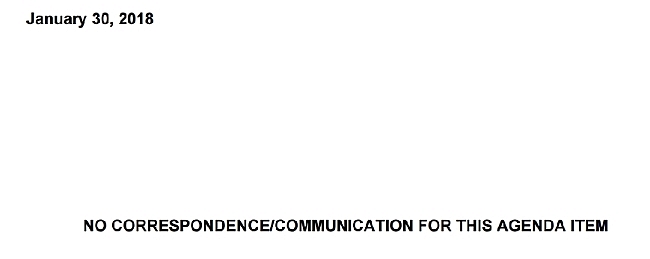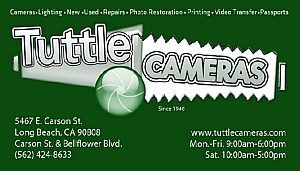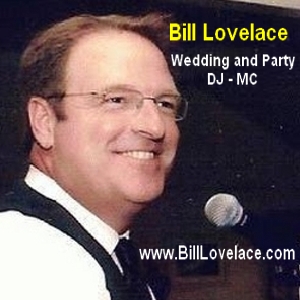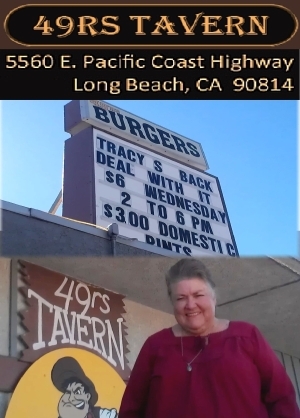Mayor Garcia didn't mention the major LB-impacting project during his mid-January 2018 "State of the City" message. About two weeks later, the LB City Council's "I-710 Oversight Committee" (which doesn't have project approval power but consists of three LB Councilmembers [Uranga, Austin and Richardson] with districts along LB's 710 corridor) scheduled a
The Council Committee provided no online agenda materials for public review prior to its meeting (screen save below as of 10:30 a.m. on the meeting date) and meeting materials didn't materialize online until after the Committee was over.

Source: I-710 Oversight Committee meeting agenda slide, Jan. 30, 2018, visible prior to meeting to select "locally preferred alternative" for I-710 project
Sponsor | Sponsor |
Materials belatedly visible online show the City of Long Beach submitted October 17, 2017 written comments voicing concern over aspects of the project's EIR, which can be viewed here.
Written materials also include opposition to Alternatives 5C and 7 in a letter dated January 25, 2018 by the Coalition for Environmental Health and Justice to the Gateway Council of Governments (on which Councilman Austin is LB's representative.) The group's letter can be viewed here.
The group's opposition focused on zero emissions ("Our communities deserve a project that advances zero emissions in a meaningful way, not just a project that widens the road and hopes zero emissions technology will come. A mandatory zero emissions corridor or lanes is a critical component to any project"); displacement ("We remain deeply opposed to the project displacing homes and homeless facilities. The consultants must do a better job in designing a project that protects these vital resources") and targeted hiring (including a "project labor agreement") It also faulted the project's environmental review process for not putting out a preferred alternative during the environmental review process and then "rushing to select an alternative shortly thereafter."
The group's letter urges rejection of Alternatives 5C and 7 and asks that the project team address the issues in its letter and revise and recirculate the project's environmental documents accordingly. .
At the Jan.30 Committee meeting, Metro reps presented a Power Point presentation (obviously prepared in advance and belatedly visible here) and recommended Alternative 5C (ten freeway lanes at a cost of roughly $6 billion) over Alternative 7 (with an elevated four lane "Clean Freight Corridor" at a cost of roughly $11 billion.) Both alternatives involve taking 100+ homes and businesses for onramp/off-ramp upgrades.
Metro's rep told the Council Committee that the Metro "project team" recommended Alternative 5C as the "Locally Preferred Alternative" on grounds it would accomplish the agency's stated purpose and need of the project, offers a number of benefits, and has fewer impacts than Alternative 7. Metro's rep told the Committee that although full funding for Alternative 5C isn't "currently available," Metro and Caltrans have sufficient funding to support accelerated implementation of its initial stages (Early Action Projects) while additional funding "becomes available." The Committee was told that Alternative 5C can be constructed in stages while Alternative 7's benefits are associated with a proposed Freight Corridor that can't be constructed in stages that would have independent utility.
A number of residents and grassroots groups testified in opposition to Alternative 5C with several urging the Council Committee to recommend that Metro halt the project's advance and re-work it to focus to a greater extent on health and community benefits.
- To hear the public's testimony, click here.
- To hear the three Councilmembers' responses (in order: Uranga, Austin and Richardson) prior to their vote support Alternative 5C, click here
In colloquy with a Metro rep, Committee member/Vice Mayor Richardson said [paraphrase] he views the project as an opportunity to correct a chronic NLB injustice in the current configuration of the 710/91 interchange which leaves some adjoining land areas "land locked." He also voiced concern that the project's "Early Action" items north of downtown receive the same priority as downtown LB area items (which include the Shoemaker bridge entryway to downtown LB.) Richardson ultimately incorporated his concerns in the motion as made by Committee member Austin, seconded by chair Uranga, which was:
A motion was made by Member Austin, seconded by Chair Uranga, to approve recommendation to support alternative 5C and further study: [1] the I-91 and I-405 interchanges with the I-710 with intention of highest and best use of land locked parcels; and [2] early action projects for the interchanges dispersed throughout the City, specifically to include certain areas on the map are included in City's official request for early action projects further north of the Shoemaker Bridge are included with the same emphasis that have been highlighted with the Shoemaker Bridge.
The Council Committee's motion carried
Mayor Garcia's co-agendized
5.1 SUBJECT: REVISED MOTION BY DIRECTORS HAHN, SOLIS, GARCIA, AND DUPONT-WALKER 2018-0053 WE THEREFORE MOVE to direct the Metro CEO and Staff to, as part of, staff recommended Locally Preferred Alternative 5c:A. Change the Zero Emission/Near Zero Emission truck technology development program to the phased-in "Zero Emission Truck Technology Development Program."
B. Increase program funding target from $100 million to $200 million, and include in the Program incentives and grants investment in the acceleration of zero emission technology both for long hauling trucks and for freeway infrastructure, including but not limited to, "under the pavement" vehicle charging capacity as options to consider.
C. Convene a working group comprised of the California Air Resources Board (CARB), California State Department of Transportation (Caltrans), Southern California Association of Governments (SCAG), South Coast Air Quality Management District (AQMD), California Transportation Commission (CTC), the Ports of Los Angeles and Long Beach, zero-emission industry experts and other key stakeholders to develop a policy recommendation for a full, zero-emission only, dedicated lane including, but not limited to "rechargeable roadways" on the entire 19 mile long stretch of the 710 freeway, as part of the reevaluation of the remaining elements of Alternative 5c, after the Early Action Projects have been completed.
In their agendizing memo, co-agendizers Hahn, Solis, Garcia and
...There are now three alternatives for the Metro Board to choose from: "No Build", "5c" and "7." Both include a funding target of $100 million for the purchase of "Near Zero" (NZE) or "Zero” emission (ZE) trucks that would travel on the 710 corridor. Yet, according to AQMD, even taking into consideration either build alternative, "the region will need substantial additional emission reductions to attain the National Ambient Air Quality Standards." Additionally, Metro has reported that greenhouse gas tailpipe emissions would be reduced by nearly the same levels for either alternative.Dedicating the funding exclusively to "zero emission" technology once is available and requiring only ZE vehicles be allowed - once they are constructed - could improve air quality standards significantly. The technology for long haul trucks that would emit NO poisonous fumes is emerging quickly, as exhibited by leading auto manufacturers such as Tesla and Daimler AG. Freeways in China, Israel and Norway are being constructed to have electric chargers embedded under the pavement, thus enabling electric vehicles - both cars and long haul trucks - to charge their batteries as they are moving. This significant investment by Metro can be a game-changing accelerator of "zero emission" technology, eliminating the need to subsidize "near zero" emission vehicles.
The future 710 freeway must not be a "diesel death zone" but a corridor where freight can be moved quickly without impairing the health of communities alongside the 710 Freeway. Both can be achieved.
Sponsor |  |
In a separate but related item, Garcia explicitly joins with Metro Directors Solis, Ridley-Thomas, Butts, Najarian and Hahn in supporting 5C as Metro's "Locally Preferred Alternative."
5.2 SUBJECT: MOTION BY DIRECTORS SOLIS, GARCIA, RIDLEY-THOMAS, BUTTS, NAJARIAN, AND HAHN 2018-0068WE THEREFORE MOVE that the Board adopt Alternative 5C as the Locally Preferred Alternative for the I-710 South Corridor Project FEIR/FEIS (inclusive of Motion 22.1 from October 2015) and expedite the delivery of an Early Action Program (EAP) that emphasizes the following:
A. Projects that deliver the most immediate and significant benefits related to safety, mobility and air quality;
B. Projects that can be implemented with minimal or no displacement of residences, businesses, and sensitive land uses;
C. Developing a local/targeted hiring policy that is applicable to any and all eligible funding sources;
D. Conduct an operational performance analysis upon completion of the Early Action Program utilizing the most current State and local evaluation measures and standards to re-evaluate and re-validate the remaining elements of Alternative 5C, especially identifying opportunities to further reduce property impacts;
E. Return to the board upon completion of the aforementioned directive to seek further consideration and authorization related to implementing the balance of improvements in Alternative 5C.
FURTHER MOVE that the Board direct the CEO to establish a working group with the freight industry, air quality regulators, transportation and metropolitan planning agencies, the Gateway Council of Governments and other relevant stakeholders to explore the lead authorities, financial impact and other implementation factors related to:
A. Develop a strategic plan that is consistent with the South Coast Air Quality Management Plans, which expedites the transition from diesel freight trucks to near-zero emission vehicles as soon as possible and outlines a transition to zero-emission vehicles as the cleanest, most reliable technology becomes available;
B. Host an industry forum aimed at stimulating and accelerating the deployment of cleaner freight truck alternatives. The forum shall include, but not be limited to topics such as funding and financing, public-private partnerships, new technologies, on- and off-dock rail support facilities, best practices research and development, demonstration programs (example: rechargeable roadways), creative purchase/lease incentive programs, etc.;
C. Develop and evaluate multiple scenarios for a comprehensive congestion demand management program, to be evaluated independently, that focuses on separating freight and non-freight vehicles (i.e. dedicated toll lanes) within the existing rights of way on freeways facilities throughout Los Angeles County with priority on Near-Zero and Zero-Emission vehicles;
D. Develop an overarching transportation demand management (TDM) strategy consistent with the larger, previously approved TDM strategy development process that will minimize the impact of goods movements and people in the surrounding communities along the I-710 corridor. FURTHER MOVE that the CEO works with the Gateway Cities Council of Governments to assess the effectiveness and recommend potential improvements to the community participation structure that was established for the environmental review period. Report back to the board in 120 days.
FURTHER MOVE that, as part of its NextGen Bus Study, Metro evaluate the feasibility of implementing high-frequency bus service in accordance with Motion 22.1 (October 2015).
Developing.
Sponsor | Sponsor |
blog comments powered by Disqus
Recommend LBREPORT.com to your Facebook friends:
Follow LBReport.com with:
RSS |
Contact us: mail@LBReport.com





Hardwood Floor Specialists
Call (562) 422-2800 or (714) 836-7050
